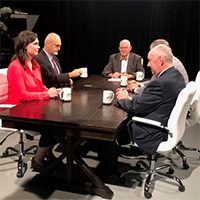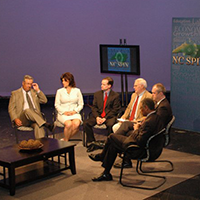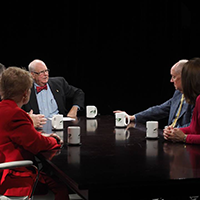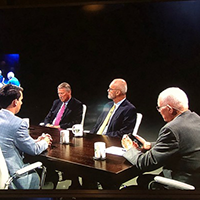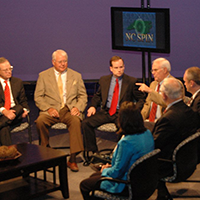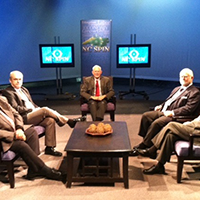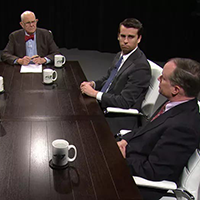The rise of North Carolina's unaffiliated voter. Who are they?
Published November 25, 2021
By Michael Bitzer, Chris Cooper, Whitney Ross Manzo, and Susan Roberts
Recently, the four of us presented a co-authored paper entitled "The Rise of the Unaffiliated Registered Voter in North Carolina" at the "State of the Parties: 2020 and Beyond" conference hosted (virtually) by the Ray C. Bliss Institute of Applied Politics at The University of Akron. This post summarizes our key findings regarding the fastest growing group of registered voters in the state, and the group that will likely become the state's largest registered voter block sometime in 2022.
The Beginnings of the Unaffiliated NC Voter Rise
We trace the rise of the unaffiliated voter in NC back to 1977, when the NC General Assembly passed House Bill 48, which converted the then-registered "independent" or "no party" designees on the state's voter rolls to "unaffiliated" party status.
Yet it would be 1986 before NC began to see the significant rise in unaffiliated voters. That same year was when the U.S. Supreme Court handed down a decision giving political parties in the states the right (under the First and Fourteenth amendments) to decide whether their primary elections would be open to other voters than just those registered with the party. This "closed" primary system, where only registered voters of the party could participate in the selection of the party's nominees, was the previous system that North Carolina used.
However, one year later, the NC Republican Party opened up their primaries to Unaffiliated registered voters (still barring registered Democrats however) following passage of another NC law that granted the state's political parties the right to vote in the primary election.
It would be another eight years, however, before the NC Democratic Party would open up its primaries to Unaffiliated voters (yet again, barring registered Republicans from participating).
As shown in this graph, the period 1977 to 1990 saw registered Unaffiliated voters at about five percent of the state's total voter pool, but after 1990, the percentage of registered voters begins to escalate quickly, rising to 15 percent of the pool by the turn of the 21st Century.

As of 2021, one-third of the state's registered voters are Unaffiliated, with 35 percent of them registered Democrats and 30 percent registered Republicans.
The figure also makes clear the effects of policy choices on party registration. In the first era, where Unaffiliated voters were shut out of the primary process, their rise was almost imperceptible—averaging an increase of only 2 hundredths of a percentage point per year.
The second era, however, when Unaffiliated voters were permitted to vote in the Republican primary, saw a rate of increase approximately 32 times the increase in the first era—from an average of .02 percentage points per year to an increase of .64 percentage points per year.
Beginning in 1996, Unaffiliated voters could choose to vote in either both major party’s primaries and once again, the effects were clear. During this third era, Unaffiliated registration increased by .88 percentage points per year—the highest of the three eras. The same period also saw decreases in both Republican and Democratic membership (-.24 and -.67 percentage points, respectively).
Who are the Unaffiliated Voters in NC?
Using data from the NC State Board of Elections, we go back to the 2008 presidential election to present the demographic compositions of not just the Unaffiliated registered voter, but also the partisan registered voters as well for a comparative analysis. Table 1 gives the election composition of registered voters for the three major groups--Democratic, Republican, and Unaffiliated--by race & ethnicity:

In general, what we find is that the Unaffiliated registered voter block comes closest to mirror the overall state dynamics, while the Democratic registered voter group transitions into a majority-minority group (beginning in 2016's election) and the Republican registered voter group is dominated by White non-Hispanic voters.
Between 2008 and 2016, Unaffiliated voters were seven percentage points more White/non-Hispanic/Latino, eleven points less Black/African American non-Hispanic/Latino, and one point more Hispanic/Latino than the state as a whole.
In 2018 and 2020, though, the difference between the Unaffiliated and the state-wide White non-Hispanic/Latino percentage points dropped to five and three percent, respectively, while the difference among Black percentages decreased to nine percentage points. However, the "unknown/unreported" race and ethnicity category was higher among Unaffiliated voters compared to the state (four points higher) in 2020. This is likely due to the North Carolina State Board of Elections' online voter registration portal not asking for a voter's race or ethnicity in 2020.
Another component of the data is to divide the party registrations into generation cohorts. Table 2 again presents the three largest groups, going back to the 2008 election, and gives the cohort break-downs (cohorts are defined by the Pew Research Center's generational cohort definitions):

The rise of the Unaffiliated NC voter has been driven primarily by two cohorts: Millennials and Generation Z, those voters born after 1981. Yet this unaffiliated status wasn't the case with early Millennial voters.
A plurality of Millennial voters registered Democratic from the period 2008 through 2012: in each of those election years, 40 percent of Millennials registered as Democratic, while 32 to 34 percent registered Unaffiliated and 26 percent registered Republican.
Since 2014, however, pluralities of the two cohorts have registered Unaffiliated, ranging from 40 percent of Millennials in 2014-2020, while 46 percent of Generation Z voters registered Unaffiliated in 2018 and 2020. Registered Republicans have the lowest registration percentages among these two cohorts: 24 percent among Millennials and 22-23 percent among Generation Z.
What Are Unaffiliated Voters' Political Attitudes and Policy Stances Like?
Based on data from the Meredith Poll, we turn to analysis of a series of survey questions that attempt to understand the nature of public opinion in this key group of partisan registrants. Among other things, we are interested in exploring to what degree their public opinion might resemble one party or another.
We asked each poll respondent their ideological identification and tracked it against their self-reported party identification.

As could be expected, Democrats were more likely to self-report as liberal, Republicans were more likely to self-report as conservative, and Unaffiliated voters were more likely to self-report as “somewhere in the middle.” One-quarter of Republicans and Democrats also counted themselves as “somewhere in the middle.” Notably, Unaffiliated voters were slightly more likely to identify as conservative than liberal (only 4%).
We asked a question among whether the respondents are satisfied with the direction of the country. As expected, partisans respond thermostatically—rising when their party is in power and falling when their party is out of power.

Unaffiliated registrants, however, respond less thermostatically—falling in the middle of both parties, regardless of which party is in control of the White House.
A majority of all partisans in three different polls reported believing that the current political parties do such a poor job that a third party is needed, with the exception of the Democrats in 2021 (but it’s close at 47%).

However, Unaffiliated voters have reported that they believe a third party is needed at higher levels than Republicans and Democrats. This is understandable given that Unaffiliated voters are, by definition, not tied to either of the two major political parties.
Interestingly, since 2018, the number of Unaffiliated voters who feel this way has slowly but steadily increased. This is likely related to our other findings on the sharp increase in Unaffiliated voters in North Carolina, because those who would become so disenchanted with a party that they would deregister as a partisan and choose to become Unaffiliated would likely believe that a third party is necessary.
We also asked two policy questions to see if the Unaffiliated voters would be better described as “leaners” or “light” partisans. The first question involved whether the respondent believed it was important for the United States to raise taxes on households making over $400,000, which is a Democratic proposal that might make it into the current infrastructure bill.

As can be seen above, Democrats understandably support this measure more than Republicans or Unaffiliated voters. Republicans were divided, with a plurality believing the proposal was critical or important and nearly one-third believing the proposal to be not important. Unaffiliated voter support is between the levels found among Democrats and Republicans, lending support to their claims of being “somewhere in the middle,” but among those who find the proposal critical or important and those who find the proposal not important, the Unaffiliated voters were closer to the Republican voters.
The second policy question was about the importance of community college, which is another Democratic proposal that has been floated for several years but was recently removed from the current infrastructure bill. Again, more Democrats find this issue critical or important than Republicans and Unaffiliated voters, and Republicans are more divided.

This time, though, a plurality of Republicans believe free community college is not important, and only 29% find it critical or important. Unaffiliated voters hold views more similar to Republicans on this issue as well.
Finally, How Might Registered Unaffiliated Voters Vote?
With the continued rise, and likely assumption of the largest voter block in North Carolina sometime in 2022, many have asked the question: how do registered Unaffiliated voters vote?
To address this question, we computed an electorate composition percentage for registered Democrats, Republicans, and Unaffiliated voters, along with the two-party precinct vote percentage Donald Trump in the 2020 presidential election contest. To visually assess what, if any relationship, might be present, we analyzed the data through scatterplots of partisan voter composition for each presidential candidate.

First, the above figure presents the Registered Democratic Precinct Electorate Percentage to Biden's Two-Party Precinct Vote Percentage, and shows a clear upward slope (the adjusted r-squared value is 0.694). This signifies that as the percentage of the registered Democrats casting ballots increased in the precincts, so too did Biden's two-party vote percentage.
The same dynamic was found in the following figure with the Registered Republican Precinct Electorate Percentage and Trump's Two-Party Precinct Vote Percentage, though the adjusted r-squared value was much higher (0.827).

Next, we estimated a scatterplot for the precinct-level electoral composition measure of registered Unaffiliated voters on the Trump vote in 2020.

The explanatory power of the Unaffiliated precinct electorate was close to zero, however the slopes of the line-of-fit indicated that as the Unaffiliated percentage increased, the Two-Party Vote Percentages for Trump increased.
This suggests that as the percentage of Unaffiliated voters (again, the fastest growing group of registered voters in the state) increases, they tended to lean more Republican in the 2020 Presidential election. Further analysis of this dynamic is needed on this question, and is a project for the future.
A final analysis of registered Unaffiliated voters took a look at those who consistently voted in a party primary election for 2012, 2016, and 2020, using the November 2020 voter registration data and voter history data files.
Interestingly, the number of registered Unaffiliated voters who participated in all three of the Democratic primaries or in all three of the Republican primaries (113,466) was evenly divided: 50 percent of the Unaffiliated were consistent Democratic primary voters, and 50 percent were consistent Republican primary voters.
Yet there are stark differences in the composition of those party-primary Unaffiliated voters, as shown in the following table:

Among White non-Hispanic Unaffiliated voters, 56 percent voted in GOP primaries, while 44 percent voted in Democratic primaries. Not surprisingly, Black/African American non-Hispanic Unaffiliated voters participated overwhelmingly in the Democratic primaries (96 percent), while Hispanic/Latino Unaffiliated voters were 74-26 percent Democratic primary voters over Republican primaries. This pattern of at least 70 percent consistent Democratic primary voters held for other voters of color (Asian, American Indian, multi-racial, and other races, all non-Hispanic).
The "gender gap" that has been well documented in American politics was evident in the consistent primary voter data as well: 54 percent of Unaffiliated women consistently participated in the Democratic primaries, while 55 percent of Unaffiliated men consistently participated in GOP primaries.
Among generational cohorts, Millennials and Generation X Unaffiliated voters were overwhelmingly consistent Democratic primary voters (68 and 59 percent, respectively), while Boomers and Greatest/Silent generation Unaffiliated voters flipped to being consistently Republican primary voters (54 and 62 percent, respectively).
Finally, in looking at the 'regions' of these consistent party primary Unaffiliated voters, it is not surprising that central city Unaffiliated voters were 3-1 consistent Democratic primary voters. What was somewhat surprising was that among urban suburb Unaffiliated voters, 54 percent were consistent Democratic primary voters to 46 percent consistent Republican primary voters. Among surrounding suburban county Unaffiliated voters, the numbers flipped in partisan primary participation: 65 percent were consistent Republican primary voters. Finally, rural county Unaffiliated voters were also consistent GOP primary voters, at 63 percent.
So What Does All This Tell Us About NC's Registered Unaffiliated Voters?
In terms of demographics, Unaffiliated registrants tend to represent a "bridge" between the two partisan registered voter groups of Democrats and Republicans. More racially and ethnically diverse than Republicans, but not as diverse as Democrats, Unaffiliated voters tend to more closely mirror the state's overall race and ethnicity of all registered voters.
In terms of age, registered Unaffiliated voters skew younger than their partisan registered voters, due to the significant proportion of Unaffiliated voters being Millennials and now Generation Z.
A significant question in the state's politics is, where do these registered Unaffiliated voters tend to lie in their partisan identification? While additional research needs to be conducted, we find an equally divided group of Unaffiliated voters splitting their party preferences, reflecting the intensely competitive nature of the state's overall political dynamics.
Further research, perhaps utilizing the percentage of a precinct's electorate that is Unaffiliated and casting votes in general elections, would be another potential way to measure how Unaffiliated North Carolina voters are deciding their partisan support.
A review of public opinion data reflects similar trends—Unaffiliated voters in North Carolina are not simply closet partisans. They hold distinct political beliefs that fall somewhere between the two major parties on most issues. Indeed, the only example where they do not fall within the two major parties is on the question of the two-party system itself, where Unaffiliated voters are, perhaps not surprisingly, less than enthralled with the current system.
Altogether, this exploration suggests that the rise in Unaffiliated voters is a trend that should not be ignored and Unaffiliated voters do hold distinct political views, on average. The two major parties should pay attention to this trend and attempt to arrest its development—not only because of what it means for profiling potential voters, but also for what it means for party organization and candidate recruitment, the lifeblood of political parties.
With apologies to American Express, the two major parties need to explain why “membership has its privileges,” lest they, too, will be shut out of important markets.

